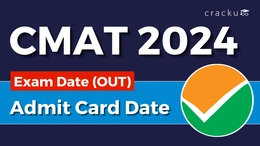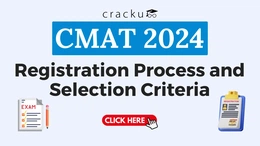Embarking on your MBA journey requires strategic planning and consistent preparation, especially when it comes to conquering the Common Management Admission Test (CMAT) 2024. Scheduled to be conducted in April/May 2024, its registrations are expected to start from third week of February. CMAT is a pivotal step for MBA aspirants seeking admission to top management programs in India. Candidates are expected to thoroughly understand the syllabus, structure and marking scheme of the exam before starting their CMAT preparation.
Join CMAT 2024 Crash course here
About CMAT 2024:
Conducted by the National Testing Agency (NTA), CMAT serves as a standardized entrance examination for admission to various management programs in AICTE-approved institutions and universities across India. The test evaluates candidates on their proficiency in Quantitative Techniques, Logical Reasoning, Language Comprehension, General Awareness, and the recently added "Innovation and Entrepreneurship" section. Nearly 70,000 candidates appear for the CMAT every year. CMAT score is accepted by about 1,300 B-schools in India including Goa Institute of Management, Great Lakes Institute of Management, , K J Somaiya Mumbai, Welingkar Mumbai, and JBIMS.Also Read, CMAT Paper Analysis 2024
Understanding CMAT Structure:
CMAT distributes 20 questions to each of its five sections, summing up to a total of 100 questions. The exam spans 180 minutes, with a total of 400 marks. Each question of the exam carries 4 marks , +4 is awarded for each correct response and -1 is deducted for every incorrect response. There is no deduction for unattempted questions.Mastering each section is crucial to securing a competitive edge in the admissions process.Section-Wise Preparation Strategy:
-
Quantitative Techniques and Data Interpretation (QT & DI):
- Conceptual Clarity: Begin with a thorough understanding of basic mathematical concepts. Strengthen your foundation before tackling advanced topics.
- Practice Variety: Solve a diverse range of problems covering different difficulty levels. This helps in adapting to various question patterns.
- Time Management: Practice time-bound problem-solving regularly to improve efficiency during the exam. Develop the skill to identify quicker approaches to solve problems.
- Shortcut Techniques: Learn and employ shortcut techniques for calculations. This can save valuable time during the exam, especially in data interpretation.
- Topic Prioritization: Identify your strong and weak areas within Quantitative Techniques. Devote more time to weaker sections while maintaining proficiency in stronger ones.
- Visualization Techniques: Develop a systematic approach for Data Interpretation. Start by understanding the given data, identify key information, and then proceed to solve questions. Improve your ability to visualize and interpret data sets. This skill is crucial for efficient data analysis and interpretation.
-
Logical Reasoning (LR):
- Daily Puzzle Practice: Dedicate time each day to solving puzzles. Regular practice enhances your logical reasoning skills and boosts problem-solving speed.
- Variety in Question Types: Explore a variety of logical reasoning question types, including seating arrangements, coding-decoding, and series completion. Familiarity with diverse question formats prepares you for any challenge.
- Mind Mapping: Develop mind mapping techniques to visually organize information. This helps in structuring thoughts and making connections between different elements of a problem.
- Logical Games and Apps: Utilize logic-based games and mobile apps designed for enhancing logical reasoning. These interactive platforms make learning enjoyable while honing your analytical skills.
- Parallel Thinking: Practice parallel thinking by considering multiple perspectives when analyzing a problem. This helps in identifying the most efficient approach and arriving at solutions more effectively.
-
Language Comprehension (LC):
- Diversify Reading Material: Explore a diverse range of reading materials, including articles, essays, and editorials from various genres. This broadens your vocabulary and exposes you to different writing styles.
- Regular Vocabulary Building: Dedicate time to daily vocabulary building exercises. Learn and incorporate new words into your everyday language to enhance your language proficiency.
- Practice Paraphrasing: Develop the skill of paraphrasing passages. Practice rewriting paragraphs in your own words to improve understanding and retention of information.
- Critical Reading Sessions: Incorporate critical reading sessions into your routine. Analyze articles or passages critically, focusing on the author's tone, intent, and underlying messages. This practice sharpens your ability to comprehend nuanced content.
-
General Awareness (GA):
- Stay aware of current affairs, especially in business and economics.
- Regularly read newspapers, magazines, and follow reliable news sources.
- Consistently revise essential topics to retain information.
-
Innovation and Entrepreneurship:
- Stay informed about recent innovations and entrepreneurial trends.
- Understand the fundamentals of entrepreneurship, the startup ecosystem, and business innovation.
- Practice case studies related to real-world business scenarios.







![Top 50 Important GK Questions for CMAT 2024 [PDF] Top 50 Important GK Questions for CMAT 2024 [PDF]](/media/cache/0c/98/0c9819cd0d7665a76009e5ec3d20576f.webp)
![Top 50 - GK Sports Questions for CMAT 2024 [PDF] Top 50 - GK Sports Questions for CMAT 2024 [PDF]](/media/cache/92/0a/920a99e7d7a98abf16f4df93f53b71a7.webp)
![Top 50 CMAT Innovation and Entrepreneurship Questions [Download PDF] Top 50 CMAT Innovation and Entrepreneurship Questions [Download PDF]](/media/cache/eb/2c/eb2c96ca2f3a64af1a45c68e9685e354.webp)



![Top 50 - CMAT 2024 GK Books & Authors Questions [PDF] Top 50 - CMAT 2024 GK Books & Authors Questions [PDF]](/media/cache/7c/9d/7c9db0d4a09bd4ccd7e1bc2b0a9cebb6.webp)
![Top 50 History Questions for CMAT 2024 [PDF] Top 50 History Questions for CMAT 2024 [PDF]](/media/cache/8c/1e/8c1e401acd80485973669750d38dbb5a.webp)

![Top 50 CMAT 2024 Ranks & Reports Questions [PDF] Top 50 CMAT 2024 Ranks & Reports Questions [PDF]](/media/cache/3d/36/3d3637d07014bf464d6708e07482f55e.webp)
![Top CMAT GK Sport Questions [Download PDF] Top CMAT GK Sport Questions [Download PDF]](/media/cache/8e/4d/8e4d3106062ef42f7fe113e473abf9a3.webp)

![50 Important International GK Questions for CMAT 2024 [PDF] 50 Important International GK Questions for CMAT 2024 [PDF]](/media/cache/d2/dc/d2dc638fd8abb2c1407d1dbaacb1cac7.webp)
![Top CMAT GK Awards Questions [Download PDF] Top CMAT GK Awards Questions [Download PDF]](/media/cache/a6/02/a602631086d320ef9c0bd465aeb08086.webp)

![Top 50 CMAT 2024 GK Books & Authors Questions [PDF] Top 50 CMAT 2024 GK Books & Authors Questions [PDF]](/media/cache/82/80/82806dcafba05a8dce2c842c78451754.webp)








